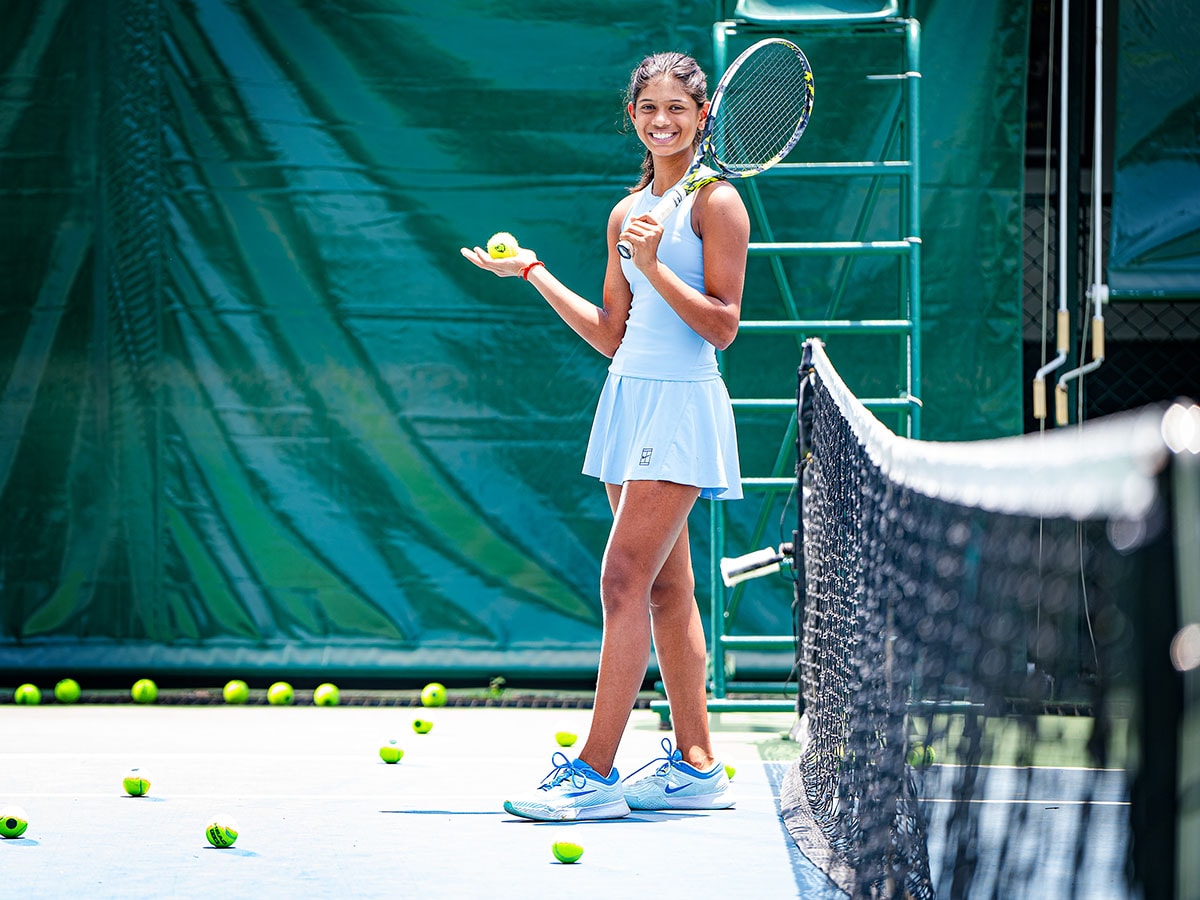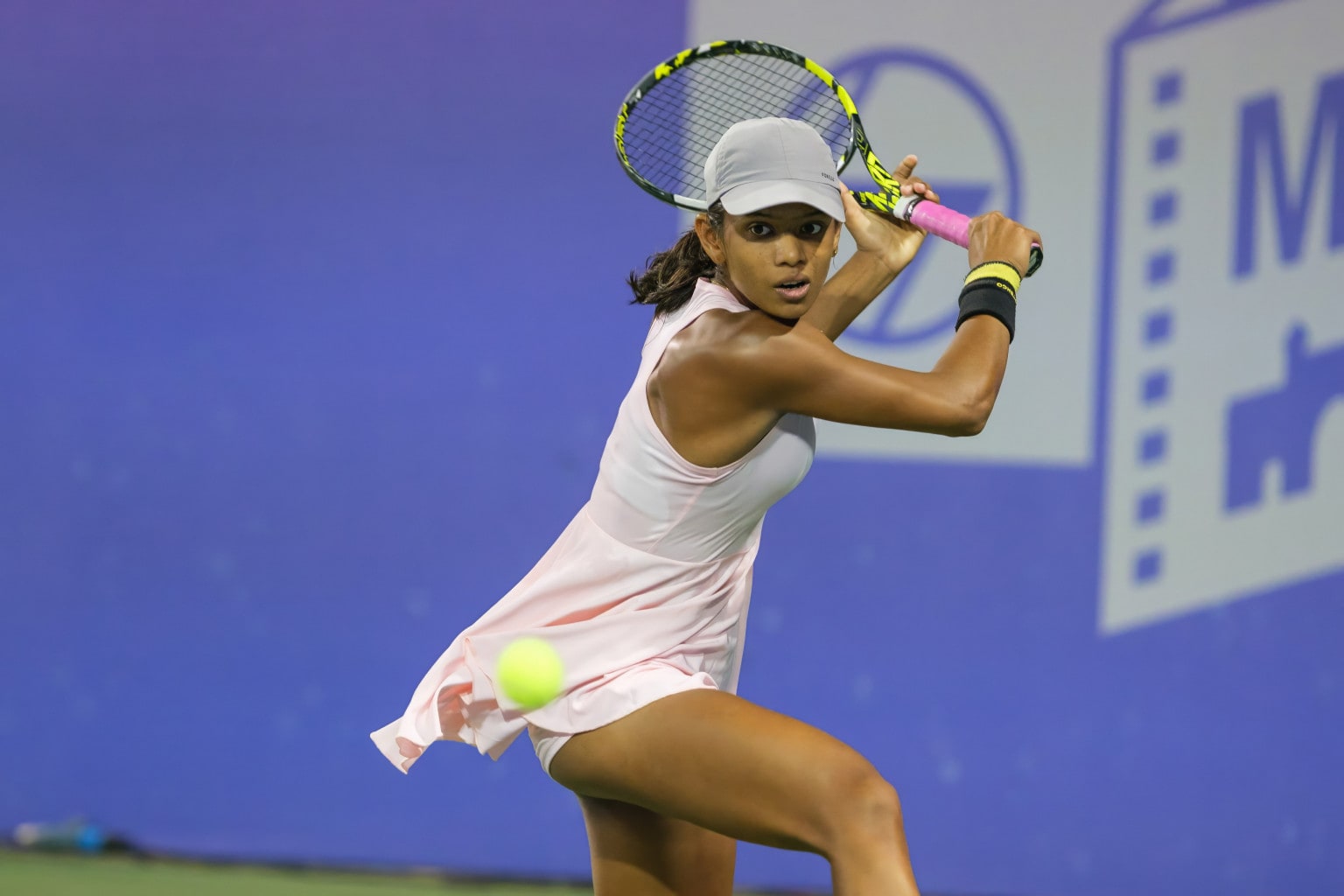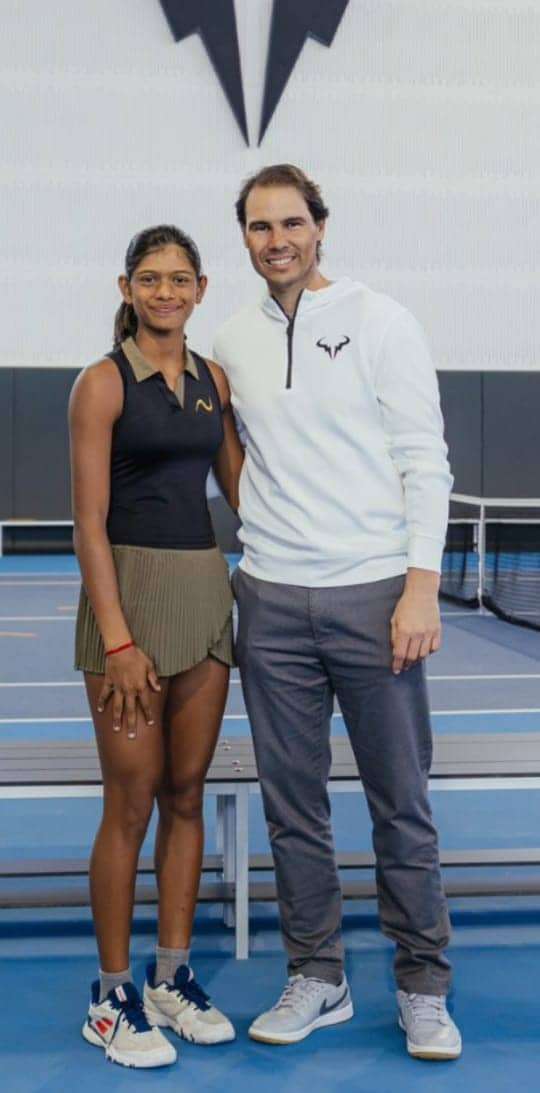 Maaya Rajeshwaran Revathi, 15, gets to rub shoulders with emerging players like Alexandra Eala (World No. 72), Alina Korneeva (No. 280), and top world juniors like Elizara Yaneva (world junior rank 18) at the Rafa Nadal Academy Image: Mexy Xavier
Maaya Rajeshwaran Revathi, 15, gets to rub shoulders with emerging players like Alexandra Eala (World No. 72), Alina Korneeva (No. 280), and top world juniors like Elizara Yaneva (world junior rank 18) at the Rafa Nadal Academy Image: Mexy Xavier
Like every 15-year-old, Maaya Rajeshwaran Revathi is quick with a Google search. Standing outside Pune’s Deccan Gymkhana, she browses and picks the nearest Oriental restaurant with the best reviews. “I love Chinese food, but I do hope it has a good tiramisu. Right now, I am obsessed with it,” she says.
Unlike most 15-year-olds, the other thing Maaya is obsessed with, and is eminently good at, is tennis. Just an hour ago, undaunted by temperatures hovering around 36 °C, she hit the court for the photo shoot, swinging hard for the balls being lobbed from the tramlines and emanating a resounding thud way beyond her age and lithe frame.
But her fierce groundstrokes aren’t just meant for the camera. A fan of Aryna Sabalenka, the hard-hitting Belarussian world number 1, Maaya unleashed heavy artillery at the L&T Mumbai Open in February, making it to the semifinal of her first Women’s Tennis Association (WTA) event. Before the start of what was only her fifth professional competition, Maaya hadn’t even faced a top 300 player; by the end of it, the then-unranked teen toppled three of them and, at World No 642 (now 655), became the youngest Indian to earn a WTA rank.
While the Mumbai Open snagged her the headlines, Maaya’s tennis prowess has been rising since age 10, when she won domestic age-group tournaments in India; since 2022, she has won six titles in the ITF junior circuit, the feeder route to the elite WTA tier. Her success in junior tournaments helped her get a spot at the prestigious Rafa Nadal Academy (RNA) in Manacor, Spain, founded by the 22-time Grand Slam champion, and where top men’s players like Casper Rudd and Felix Auger-Aliassime come to train. At the academy, where she is the first Indian student, Maaya gets to rub shoulders with emerging players like Alexandra Eala (WTA rank 72), Alina Korneeva (rank 280), and top world juniors like Elizara Yaneva (rank 18).
At the RNA—where she is on a year-long pro contract that lets her train for free—Maaya’s biggest learning hasn’t been as much about the forehands, backhands, volleys or drop shots as it has been about a tennis philosophy: How to develop tactical nous.
She narrates the story of her most celebrated senior Eala, the Filipina who had a trailblazing run at the Miami Open in March felling Grand Slam champions Jelena Ostapenko, Madison Keys and Iga Swiatek in three back-to-back matches. “Alex is not easy to play against. She can easily get you out of your comfort zone. She can do anything with her forehand,” says Maaya, who sparred with Eala before the latter headed out for Miami. But that isn’t what impressed Maaya the most. “The key is that she uses them wisely. You might have good weapons, but you need to know when to use them.”
“After a certain level, you don’t need to teach someone a forehand or a backhand. The main aspect that the coaches at RNA are working on with me is how to build tactical play,” says Maaya. “For example, everyone knows that if you are way out of the court while hitting a return, you shouldn’t change direction; you should hit straight and try to get back in. But, sometimes, in the heat of the match, you forget. At RNA, they make me play more and more points using these strategies so that it feels like a given when I play a match. Strategy should turn into muscle memory. Tennis, essentially, is a faster game of chess.”
From India to Spain
Maaya took up tennis at the age of 8 and, within two years, decided she wanted to pursue it professionally. “I loved to compete and it felt like I belonged on the tennis court,” she says. Her parents—an MNC executive father and a homemaker mother—threw their might behind her sporting pursuits despite Maaya being a meritorious student (her sports buff father recently quit his job of 17 years to be able to travel with her).
In 2023, Maaya recorded an 83 percent success rate in the ITF world juniors circuit, with five tournament wins, and an overall record of 43-9. “Her coach Manoj Kumar told us she needs more competitions, matches where she struggles to win points. That’s when we decided to move her to Europe, which is the hotbed of tennis,” says her mother, Revathi.
In late-2024, the Rajeshwarans landed in Spain to go academy-shopping. While they also recced the Pancho Academy in Valencia, in October she received an invitation to trial at the RNA. “At the end of two weeks, they told me they will take me in,” says Maaya. She joined RNA in October, and has travelled to India and other countries for tournaments since then.
 Maaya at the L&T Open in Mumbai in February, where she became the youngest Indian to earn a WTA ranking
Maaya at the L&T Open in Mumbai in February, where she became the youngest Indian to earn a WTA ranking
Moving to RNA, which houses nearly 60 courts, meant upending her life in Coimbatore; her mother joined Maaya in her rented apartment in Manacor, about a kilometre away from the academy, to keep her company and be her “cook, driver, security, all rolled into one”, laughs Revathi. Adaptations included the red clay courts, one of the most popular playing surfaces in Europe. Maaya had earlier played on clay, and even won a junior title on it at a mid-tier ITF tournament in Chennai in 2023. But Indian clay courts are one of the fastest, with speeds that can often match hard courts. “European clay demands a lot of physical rigour; we were spending a lot more time on the court,” says Maaya.
Surfaces are known to have stumped even elite players. It’s part of tennis folklore that Ivan Lendl, a Czech player who had eight Grand Slams but couldn’t conquer the grass courts of Wimbledon, called it a surface meant only for cows. But Maaya says she’s gotten the hang of slower clay over time. “Here, the point restarts after every shot. Since they were way longer, I just couldn’t blast the ball. I had to sharpen my tactical play.”
When Joan Bosch, the under-18 head coach of the RNA, saw Maaya at the trials, what caught his eye was the intensity with which she practised. “We have our style which Toni Nadal, Rafa’s uncle, followed with him; we keep it simple, but at the same time every shot needs to be intense,” says Bosch. “The week we saw her, we were impressed with her practice.”
Bosch, who had accompanied Eala at Miami Open, adds: “Maaya came in with many good things already. She can be aggressive in every shot because she’s fast, she’s strong, she’s passionate and she puts in a lot of hard work. Our job is to try and manage everything, to control her power and her shots.”
The teenager also works with two floor coaches, Miguel Fragoso and Polina Radeva, and a team of experts that look after her strength, conditioning, and nutrition. Her fitness received a thumbs-up from the academy during her admission, and she was encouraged to continue with her Indian diet. “The nutritionist said pasta, which the Europeans take for carbs, is the refined version, while rice is more natural,” says Maaya, who loves to cook at her Manacor home every Sunday.
At the academy, says Revathi, a highly professional and seamless set-up steers training modules. “If she wants to go for fitness training, they would have already communicated with the coach,” says Revathi, who watches her daughter train every day. “If the trainer feels Maaya is tired, he will inform the fitness team and ask them to reduce the load. Every schedule is micromanaged.” The RNA also provides her with travelling coaches, who accompanied her to the ITF junior tournament at Zapopan in Mexico in November.
What Maaya remembers most from her time at RNA is the proximity to the Nadals—Rafael and his uncle Toni, his coach till 2017. While Toni has coached her from time to time, her fondest moment is that one day when Rafa came visiting post his retirement and watched her train. “He keeps a close watch on his trainees. So, first thing, he congratulated me on my performance in Mumbai. He gave some technical feedback and enquired if I have settled in well since starting at the Rafa Nadal School in February.”
But Maaya’s learnings from Rafa started several weeks before she met him, when she sat on court watching him prepare for his swansong: Spain’s Davis Cup tie against The Netherlands in November. “He hit two volleys in the net, and was livid,” she says. “If someone with 22 Grand Slams can still be so upset with mistakes, can you imagine his hunger to do well?”
 Maaya with Rafael Nadal during the tennis legend’s visit to the academy
Maaya with Rafael Nadal during the tennis legend’s visit to the academy
The Nadal Effect
How Nadal’s quest for perfection has inspired Maaya will be seen over the next decade. But Maaya has started 2025 well, winning a title in New Delhi at a J300 tournament (one below the top level for juniors), making it to the semifinal of a J200 in Chandigarh, and a clinical show at the Mumbai Open. “The environment at RNA matters. The more I play at higher levels, I gain experience. I didn’t win any ITF titles in 2024, but when I came to Delhi, I felt I was ready,” she says.
Manoj Kumar, who has been training Maaya for the last five years, watched her game in Coimbatore in April, post the Billie Jean King Cup in Pune. “She has become more consistent on both flanks and has added more variety with a backhand slice and drop shots,” he says. “She has also changed to volleying with a single hand, which is easier to hit than a double-handed one.”
Once she returns to Spain in early May, the focus will turn to the Junior Grand Slam circuit, beginning with the French Open, starting May 25, where Maaya will debut this year. Bosch says they may send her to a few tournaments prior to that to acclimatise to clay. And her days—which begin at 8 am attending the Rafa Nadal School and end at 6 pm following a couple of tennis sessions and fitness training—will be loaded.
“I’ve learnt that you have to be a complete professional when you are training,” she says. Her only let-up will be Sunday mornings, when she heads to a local cafe for “the exact same order” every week: An Eggs Benedict and a pistachio cream-filled croissant.
“Maaya can hit the ball really fast. For me, the most important thing to do with her is if she can move a lot to be behind the ball and start building the point,” says Bosch. “She has very good shots, but you also need consistency and patience because tennis is a sport between winners and errors.”
Bosch breaks down why the Trinity of Nadal, Roger Federer and Novak Djokovic reshaped tennis over the last two decades. “It’s because they weren’t good over one, but many tournaments. That happens when you aim to go a level up every day instead of just winning the next tournament,” he says. “That will be the challenge for players like Maaya; to keep calm and continue learning.”
Born in Pollachi in Tamil Nadu, a young Maaya would often accompany her parents to trek the Western Ghats. Elite women’s tennis will be no less of an arduous trek, but she sure is up for it.













Leave a Reply